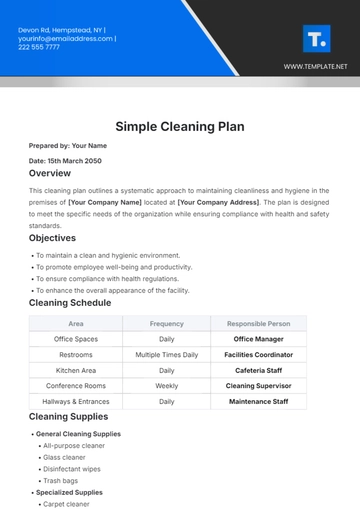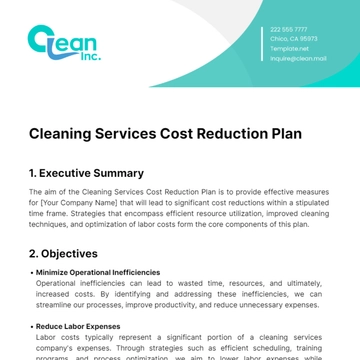Free Cleaning Services Fire Safety Plan

I. Introduction
The Fire Safety Plan (FSP) for [Your Company Name] summarizes our commitment to the health, safety, and security of our employees, as well as the preservation of our property assets against fire-related incidents. Recognizing the unique risks inherent in our industry, particularly those related to the handling and storage of cleaning chemicals and equipment, this document meticulously outlines a strategic approach for fire risk mitigation.
This encompasses a suite of measures dedicated to fire prevention, early detection, swift and coordinated response, and post-incident recovery, thereby fostering a secure and resilient workplace environment.
II. Fire Risk Assessment
To ensure a thorough understanding and proactive management of potential fire hazards within our operations, [Your Company Name] has undertaken an exhaustive fire risk assessment. This critical evaluation focuses on identifying the specific risks associated with the storage and use of cleaning materials, the operation of electrical equipment, and our storage practices.
The assessment's findings are pivotal in guiding our risk mitigation strategies, emphasizing the importance of targeted control measures to minimize risk exposure. The summarized results of this assessment are detailed in the table below, reflecting our strategic approach to managing identified risks:
Hazard | Location | Risk Level | Control Measures |
|---|---|---|---|
Flammable Liquids | Storage Room | High | Use flammable storage cabinets |
Electrical Equipment | Office Area | Medium | Regular inspection and maintenance |
Waste Material | Service Areas | Low | Daily removal and proper disposal |
This assessment is not static but a dynamic component of our fire safety protocol, subject to regular review and updates in response to changes in our operational environment or emerging best practices in fire safety management. Through this proactive and systematic approach, [Your Company Name] aims to not only comply with relevant fire safety regulations but to exceed them, ensuring a culture of safety and preparedness within our organization.
III. Fire Prevention Measures
Fire prevention constitutes a cornerstone of the Fire Safety Plan (FSP) at [Your Company Name]. Our proactive approach to fire prevention is multifaceted, focusing on the meticulous handling of materials, the maintenance of equipment, and the cleanliness and organization of the workspace. These measures are detailed as follows:
Safe Handling of Cleaning Chemicals: Employees receive comprehensive training on the proper storage, handling, and usage of cleaning chemicals. This includes understanding the specific fire risks associated with each type of chemical and the appropriate safety measures to mitigate these risks.
Maintenance of Electrical Equipment: We enforce a strict regimen for the inspection and maintenance of all electrical devices and machinery within our premises. This includes routine checks to ensure that equipment is in optimal condition, thereby reducing the risk of fire due to electrical faults.
Workspace Cleanliness and Organization: Maintaining a clean and organized workspace is imperative to prevent fire hazards. This entails regular cleaning schedules to avoid the accumulation of potentially combustible waste materials and ensuring that passageways and exits are always clear and unobstructed.
No Smoking Policy: Smoking within the premises is strictly prohibited. Designated smoking areas are established outside the building, equipped with proper disposal bins for cigarette butts, to mitigate the risk of fires started by smoking materials.
IV. Action in Case of Fire
In the unfortunate event of a fire, [Your Company Name] has established a clear and concise action plan, encapsulated in the RACE procedure. Employees are trained to execute the following steps:
Remove: The immediate priority is to ensure the safety of all individuals by removing them from the vicinity of the fire, prioritizing those in immediate danger.
Activate: The next step involves activating the fire alarm system to alert all occupants of the building and to initiate an emergency response. This is crucial for facilitating a timely evacuation and response effort.
Contain: If it is safe and feasible to do so, efforts should be made to contain the fire. This can involve closing doors and windows to prevent the spread of smoke and flames, without endangering personal safety.
Extinguish or Evacuate: Employees trained in the use of fire extinguishers may attempt to extinguish small fires. However, if the fire cannot be controlled or poses significant risk, evacuation is mandatory. The safety of personnel is paramount, and no attempt to fight the fire should impede an individual's ability to evacuate safely.
To support these efforts, a clear and detailed evacuation plan is prominently displayed in all work areas, guiding employees to safety in a calm and orderly manner. Regular drills and training ensure that all employees are familiar with the evacuation routes and procedures, enhancing our collective readiness in the face of potential fire emergencies.
V. Fire Detection and Warning Systems
At [Your Company Name], the safety and security of our premises and personnel are of paramount importance. To this end, we have implemented state-of-the-art fire detection and warning systems throughout our facilities. These systems are meticulously designed to ensure rapid detection of fires, allowing for immediate response and mitigation. The details of our fire detection and warning systems are outlined below:
System Type | Location | Testing Frequency |
|---|---|---|
Smoke Detectors | All Rooms | Monthly |
Fire Alarms | Throughout the Building | Monthly |
Our smoke detectors and fire alarms are subject to stringent testing protocols, conducted on a monthly basis, to ensure their optimal operation. By maintaining these systems in peak condition, we significantly enhance our ability to detect fires at the earliest possible stage, thereby safeguarding our employees and property.
VI. Fire Fighting Equipment
To complement our fire detection and warning systems, [Your Company Name] has strategically positioned a range of fire fighting equipment throughout our premises. This equipment is selected for its effectiveness in combating fires of various types, providing our trained personnel with the tools necessary to respond effectively in emergency situations. The distribution and availability of our fire fighting equipment are detailed in the table below:
Equipment Type | Location | Quantity |
|---|---|---|
Fire Extinguishers (Water) | Near Exits | 4 |
Fire Extinguishers (CO2) | Near Electrical Equipment | 6 |
Fire Blankets | Kitchen Area | 2 |
Each piece of equipment is chosen for its specific application, with water extinguishers placed near exits for general fires and CO2 extinguishers located near electrical equipment for electrical fires. Fire blankets are readily available in the kitchen area to address kitchen fires promptly. This strategic placement ensures that employees have immediate access to the appropriate fire fighting tools, enhancing our collective ability to respond to and control fires effectively.
Through the meticulous implementation and regular maintenance of our fire detection, warning, and fighting systems, [Your Company Name] demonstrates its steadfast commitment to creating a safe and secure working environment for all employees.
VII. Maintenance and Testing
The integrity and efficacy of our fire safety systems are paramount to ensuring the safety and well-being of all employees and the preservation of [Your Company Name]'s assets. To this end, a rigorous maintenance and testing schedule is firmly established, comprising the following key points:
Comprehensive Schedule: A detailed schedule for maintenance and testing of all fire safety systems and equipment is developed and strictly adhered to. This schedule is reviewed and updated annually to adapt to any changes in our operations or fire safety technology.
Responsibility Assignment: Specific responsibilities for the execution of maintenance and testing tasks are assigned to qualified personnel. This ensures that all activities are performed by individuals with the appropriate expertise and training.
Documentation and Records: All maintenance and testing activities are thoroughly documented, including the date of service, the nature of the service performed, and any repairs or replacements made. These records are maintained for regulatory compliance and to facilitate ongoing safety audits.
Compliance and Functionality: The primary goal of our maintenance and testing procedures is to ensure that all fire safety systems and equipment meet or exceed regulatory standards and are in optimal working condition.
VIII. Training and Drills
To foster a culture of safety and preparedness within [Your Company Name], comprehensive training and regular drills are conducted, following these guidelines:
Annual Fire Safety Training: Every employee participates in annual fire safety training sessions. These sessions cover a wide range of topics, including the use of fire extinguishers, understanding fire safety signage, and recognizing fire hazards.
Evacuation Procedures: Training includes detailed instructions on evacuation procedures, emphasizing the importance of calm, orderly, and swift evacuation during emergencies. Employees learn the locations of exits and assembly points, as well as the roles and responsibilities of designated fire wardens.
Semi-Annual Fire Drills: Fire drills are conducted semi-annually to test the effectiveness of our evacuation procedures and to ensure that all employees are familiar with their roles during an evacuation. These drills are also used to identify any areas for improvement in our emergency response plan.
Specialized Training for Selected Staff: Selected staff members receive specialized training to act as fire wardens. Their training includes advanced fire safety procedures, emergency coordination, and first aid.
By integrating these maintenance, testing, and training protocols into our operations, [Your Company Name] solidifies its commitment to creating a safe and secure workplace. These measures not only comply with fire safety regulations but also instill confidence and readiness among our staff, ensuring that we are well-prepared to respond effectively to fire emergencies.
IX. Roles and Responsibilities
The effectiveness of the Fire Safety Plan (FSP) at [Your Company Name] hinges on the clear delineation and diligent execution of roles and responsibilities within our organization. The framework for these responsibilities is as follows:
Designated Fire Safety Officers (FSOs): FSOs are the linchpin of our fire safety efforts, tasked with the comprehensive implementation of the FSP. Their duties include:
Developing and updating fire safety policies and procedures.
Conducting regular fire safety training sessions for all employees.
Coordinating with local fire services for emergency response planning and joint drills.
Conducting periodic audits to ensure compliance with fire safety standards.
Employees: All employees play a vital role in our fire safety culture. Their responsibilities include:
Adhering to all fire safety protocols and procedures.
Participating in fire safety training and drills.
Promptly reporting fire hazards and potential risks to FSOs or management.
Acting responsibly during fire emergencies in accordance with training received.
X. Review and Revision
To ensure our Fire Safety Plan remains current and effective, a structured review and revision process is in place:
Annual Review: The FSP undergoes a comprehensive review every year. This review assesses the plan's effectiveness in light of any changes in operations, facilities, or fire safety regulations.
Post-Incident Review: Following any fire incident, however minor, a thorough review of the FSP is conducted. This ensures lessons are learned and integrated into future planning.
Documentation of Revisions: All changes to the FSP are meticulously documented, including the rationale for each revision. This documentation is essential for historical records and for auditing purposes.
Communication of Changes: Revisions to the FSP are communicated to all employees through formal channels. This may include training sessions, internal memos, or informational meetings to ensure everyone is informed and aligned with the updated plan.
XI. Conclusion
The Fire Safety Plan of [Your Company Name] represents a holistic approach to fire safety, emphasizing prevention, preparedness, and response. Our commitment to rigorous implementation and strict adherence to the plan underscores our dedication to safeguarding our employees and contributing to the safety of our community at large. Through continuous improvement and a culture of safety, we uphold our responsibility to provide a secure work environment, demonstrating our unwavering commitment to excellence in fire safety management.
- 100% Customizable, free editor
- Access 1 Million+ Templates, photo’s & graphics
- Download or share as a template
- Click and replace photos, graphics, text, backgrounds
- Resize, crop, AI write & more
- Access advanced editor
Enhance your establishment's safety measures with the Cleaning Services Fire Safety Plan Template from Template.net. Tailored to meet the rigorous demands of fire safety management, this template is both editable and customizable. Utilize our Ai Editor Tool to adapt the content to your unique environment, promoting a comprehensive approach to fire safety and preparedness.
You may also like
- Finance Plan
- Construction Plan
- Sales Plan
- Development Plan
- Career Plan
- Budget Plan
- HR Plan
- Education Plan
- Transition Plan
- Work Plan
- Training Plan
- Communication Plan
- Operation Plan
- Health And Safety Plan
- Strategy Plan
- Professional Development Plan
- Advertising Plan
- Risk Management Plan
- Restaurant Plan
- School Plan
- Nursing Home Patient Care Plan
- Nursing Care Plan
- Plan Event
- Startup Plan
- Social Media Plan
- Staffing Plan
- Annual Plan
- Content Plan
- Payment Plan
- Implementation Plan
- Hotel Plan
- Workout Plan
- Accounting Plan
- Campaign Plan
- Essay Plan
- 30 60 90 Day Plan
- Research Plan
- Recruitment Plan
- 90 Day Plan
- Quarterly Plan
- Emergency Plan
- 5 Year Plan
- Gym Plan
- Personal Plan
- IT and Software Plan
- Treatment Plan
- Real Estate Plan
- Law Firm Plan
- Healthcare Plan
- Improvement Plan
- Media Plan
- 5 Year Business Plan
- Learning Plan
- Marketing Campaign Plan
- Travel Agency Plan
- Cleaning Services Plan
- Interior Design Plan
- Performance Plan
- PR Plan
- Birth Plan
- Life Plan
- SEO Plan
- Disaster Recovery Plan
- Continuity Plan
- Launch Plan
- Legal Plan
- Behavior Plan
- Performance Improvement Plan
- Salon Plan
- Security Plan
- Security Management Plan
- Employee Development Plan
- Quality Plan
- Service Improvement Plan
- Growth Plan
- Incident Response Plan
- Basketball Plan
- Emergency Action Plan
- Product Launch Plan
- Spa Plan
- Employee Training Plan
- Data Analysis Plan
- Employee Action Plan
- Territory Plan
- Audit Plan
- Classroom Plan
- Activity Plan
- Parenting Plan
- Care Plan
- Project Execution Plan
- Exercise Plan
- Internship Plan
- Software Development Plan
- Continuous Improvement Plan
- Leave Plan
- 90 Day Sales Plan
- Advertising Agency Plan
- Employee Transition Plan
- Smart Action Plan
- Workplace Safety Plan
- Behavior Change Plan
- Contingency Plan
- Continuity of Operations Plan
- Health Plan
- Quality Control Plan
- Self Plan
- Sports Development Plan
- Change Management Plan
- Ecommerce Plan
- Personal Financial Plan
- Process Improvement Plan
- 30-60-90 Day Sales Plan
- Crisis Management Plan
- Engagement Plan
- Execution Plan
- Pandemic Plan
- Quality Assurance Plan
- Service Continuity Plan
- Agile Project Plan
- Fundraising Plan
- Job Transition Plan
- Asset Maintenance Plan
- Maintenance Plan
- Software Test Plan
- Staff Training and Development Plan
- 3 Year Plan
- Brand Activation Plan
- Release Plan
- Resource Plan
- Risk Mitigation Plan
- Teacher Plan
- 30 60 90 Day Plan for New Manager
- Food Safety Plan
- Food Truck Plan
- Hiring Plan
- Quality Management Plan
- Wellness Plan
- Behavior Intervention Plan
- Bonus Plan
- Investment Plan
- Maternity Leave Plan
- Pandemic Response Plan
- Succession Planning
- Coaching Plan
- Configuration Management Plan
- Remote Work Plan
- Self Care Plan
- Teaching Plan
- 100-Day Plan
- HACCP Plan
- Student Plan
- Sustainability Plan
- 30 60 90 Day Plan for Interview
- Access Plan
- Site Specific Safety Plan














